Your cart is currently empty!
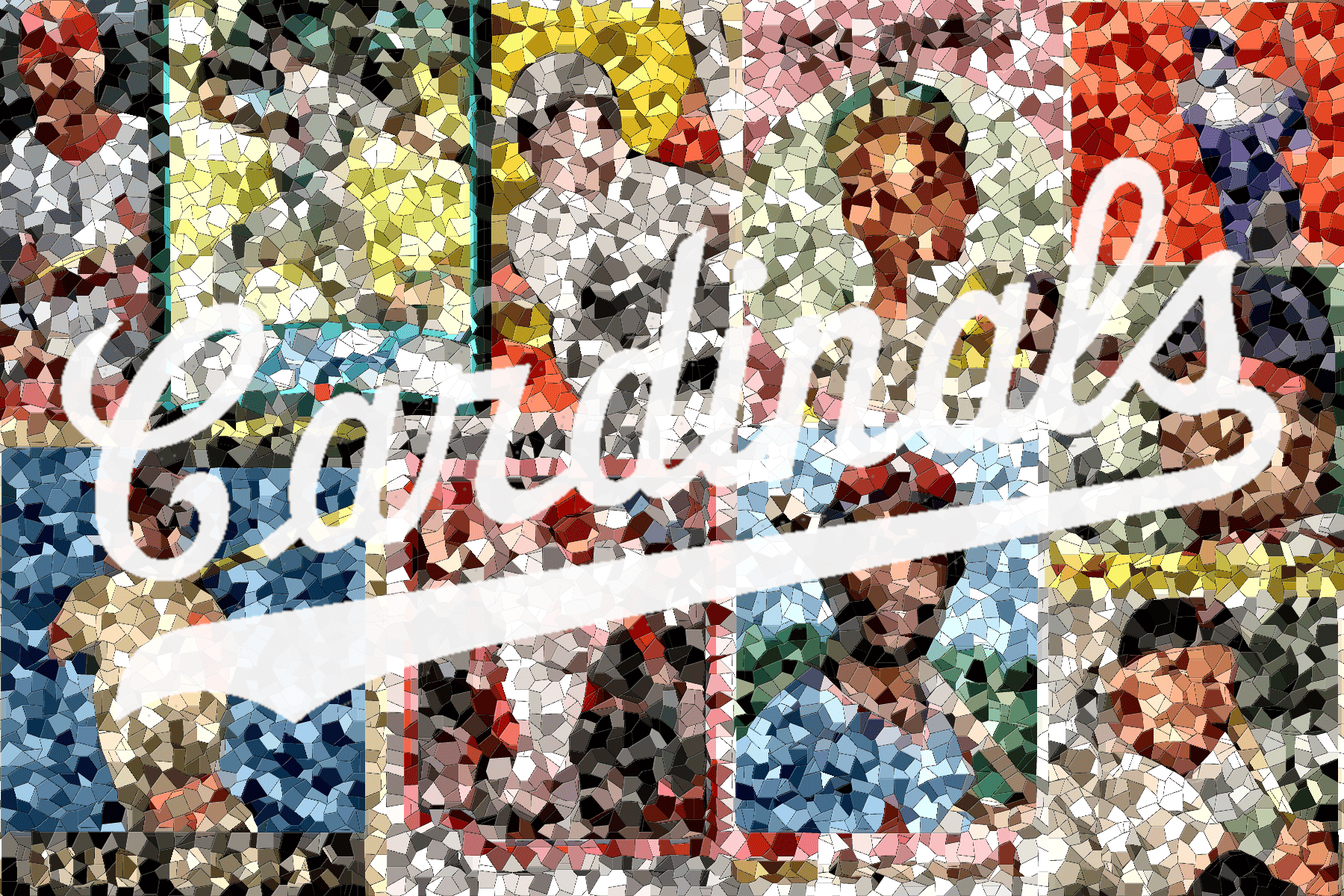
The St. Louis Cardinals boast a rich history dating back to 1882, and fans of the team have their pick of thousands of St. Louis Cardinals baseball cards. The early years in the NL were a struggle; however, the tides began to turn in 1915, and the first World Series title for the Cardinals came in 1926. Under the leadership of president Sam Breadon and general manager Branch Rickey, the Cardinals built a strong team. Notably, Rickey invested in the farm system, a strategy that would continue to pay dividends for years to come. This championship marked the beginning of a long and storied tradition of postseason appearances for the Redbirds.
[sc name=”ad-250×250″][/sc]
Then, the 1940s saw another Cardinals dynasty emerge. With a core of homegrown talent, the Cardinals won three World Series titles in a six-year span from 1942-1946. The 1942 team, nicknamed the “Gashouse Gang” for their aggressive style of play, is particularly noteworthy. They overcame a 10.5-game deficit late in the season to clinch the NL pennant and ultimately the World Series title. Then, the post-war era brought continued success. The Cardinals won two more World Series championships in 1964 and 1967, solidifying their place among baseball’s elite.
As of today, the St. Louis Cardinals stand as one of the most decorated franchises in baseball history. The team has 11 World Series titles (second only to the New York Yankees) and 19 National League pennants (third all-time). Their unwavering commitment to player development through their farm system and a passionate fanbase have all contributed to their enduring legacy.
This article covers the top 10 players in St. Louis Cardinals history, spanning over 100 years of Cardinals baseball cards and showing the best and most interesting the team has to offer.
10. Yadier Molina
Player History
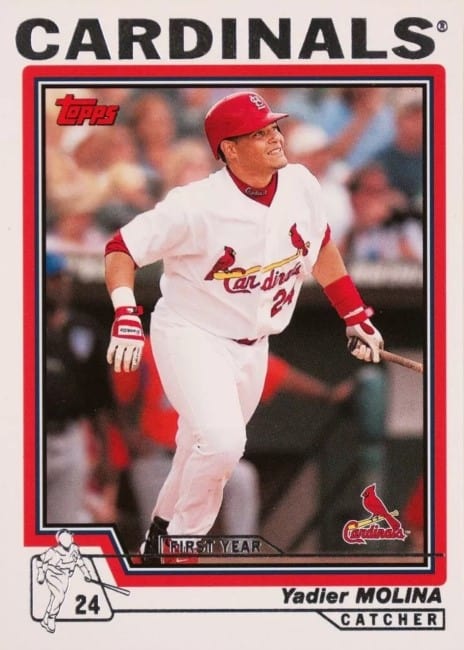
Yadier Molina, nicknamed “Yadi” by fans and teammates alike, spent his entire 19-year Major League Baseball career (2004-2022) with the St. Louis Cardinals. He primarily played catcher, establishing himself as one of the most defensively gifted backstops in baseball history, renowned for his game-calling, pitch-framing, and throwing arm.
Molina’s Cardinals career was a masterclass in defensive mastery. He won a staggering nine Gold Glove Awards. He led the league in caught-stealing percentage in four seasons, topping the list with 64% in 2005. Also, Molina played a key role in both the Cardinals’ 2006 and 2011 World Series victories, earning praise for his leadership and game-calling skills.
Yadier Molina also made 10 All-Star teams and maintained good offensive statistics, with a career batting average of .277 and 2,168 hits – good for third on the Cardinals all-time list. This is a testament to his longevity and consistency.
Unlike most catchers, Molina never transitioned away from catching as he aged. His value lasted his entire career. In addition, he was a respected figure in the Cardinals clubhouse, representing the team in a positive light for 19 years. He currently serves as the Special Assistant to the President of Baseball Operations.
Yadier Molina retired in 2022 and is not yet eligible for the National Baseball Hall of Fame.
Best St. Louis Cardinals baseball card: 2004 Topps Yadier Molina #324 (RC)
As a player in the 2000s, Yadier Molina has a lot of rookie cards to choose from, including options from Bowman, Donruss, Heritage, Leaf, Topps and more. The best, though, is the classic offering from Topps 2004 flagship set. It’s available in a base version, plus chrome, gold and black. These Yadier Molina Cardinals baseball cards are easy to acquire, and cost about $15 in ungraded condition.
9. Adam Wainwright
Player History
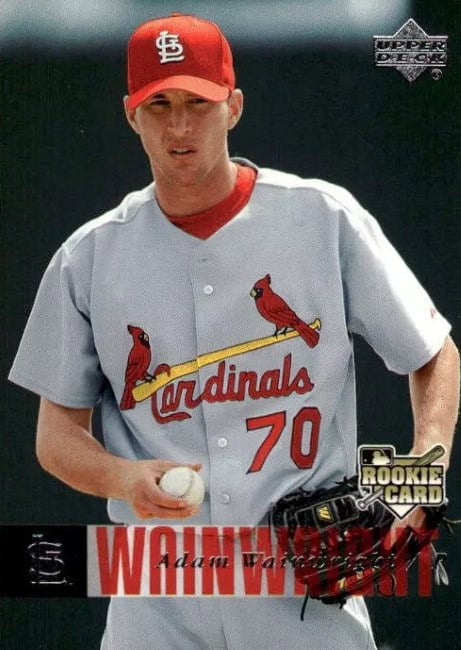
Adam Wainwright, affectionately nicknamed “Waino” by Cardinals fans, pitched for the St. Louis Cardinals for a remarkable eighteen seasons (2005-2023). Primarily known for his exceptional control, pinpoint accuracy, and competitive fire, he established himself as a franchise cornerstone and a leader on and off the field.
Wainwright’s tenure with the Cardinals was a period of sustained excellence and postseason success for the team. He compiled a stellar record of 200 wins (third in Cardinals history) and 2,202 strikeouts (second in Cardinals history). Wainwright led the league in wins and innings pitched twice, in 2009 and 2013. Although he never won a Cy Young award, he finished in the top three in voting four times between the 2009 and 2014 seasons.
More importantly, Wainwright thrived in the postseason. He played a pivotal role in the 2006 playoffs, culminating in a World Series win. In 9 ⅔ innings as a reliever, Wainwright recorded four saves and didn’t give up any runs. Accordingly, he was on the mound for the final out in Game 5, ending the World Series on a strikeout. Wainwright also appeared on the 2011 World Series-winning roster, as he recovered from Tommy John surgery. His leadership as a veteran presence in the clubhouse was invaluable, guiding younger pitchers and fostering a winning culture.
Adam Wainwright retired in 2023. He is currently a broadcaster for MLB Network and FOX Sports, and he’s pursuing a country music career. He is not yet eligible for election to the National Baseball Hall of Fame.
Best St. Louis Cardinals baseball card: 2006 Upper Deck Adam Wainwright #424
Adam Wainwright’s true rookie cards show him in his pre-Cardinals days as a Braves prospect. In his rookie season, Wainwright didn’t have a Topps card, but his Upper Deck issue is a beauty. Featuring a full-bleed design and a high-contrast photo, this card celebrates his rookie season as a relief pitcher. The card is worth around $5 in ungraded condition, or $50-$100 for a PSA 9.
8. Enos Slaughter
Player History

Enos Slaughter, nicknamed “Country” for his North Carolina roots, patrolled the outfield for the St. Louis Cardinals for nineteen seasons (1938-1942, 1946-1959). Slaughter was a well-rounded player with a solid batting average and respectable power. However, his legacy is defined by his hustle and a single, unforgettable moment.
Slaughter’s career with the Cardinals was marked by consistency and a knack for being in the right place at the right time. He compiled a lifetime batting average of .292 with the Cardinals, collecting 2,383 hits, 169 home runs, and 1,237 RBIs. He was a three-time National League All-Star (1950, 1952, 1953), showcasing his consistent offensive contributions. However, his most significant impact came in the realm of postseason heroics. In the 1942 World Series victory over the New York Yankees, Slaughter batted a crucial .320 with a home run and 3 RBIs. But it was his performance in the 1946 Fall Classic that cemented his place in Cardinals lore.
His defining moment arrived in Game 7 of the 1946 World Series against the Boston Red Sox. With the score tied in the eighth inning and two outs, Slaughter was on first base. His manager called for a hit-and-run, and when the batter delivered a single to left-center field, Slaughter ran through his coach’s stop sign and scored the winning run, securing the World Series victory for the Cardinals. In 1999, the Sporting News named it the #10 play on their list of Baseball’s 25 Greatest Moments.
Enos Slaughter was elected to the National Baseball Hall of Fame in 1985 by the Veterans Committee.
Best St. Louis Cardinals baseball card: 1952 Bowman Enos Slaughter #232
Enos Slaughter’s rookie year, in 1941, came a few years before mass-produced cards came into prominence. His 1941 Play Ball card, which he shares with teammate Johnny Mize, is a good selection, but we like to choose Cardinals baseball cards that feature each player. Therefore, we’ve chosen the 1952 Bowman, a landmark set that includes beautiful, full color artwork. Slaughter’s facsimile signature also crawls up the left side of this Cardinals baseball card. The card is worth about $25-$50 in ungraded condition, or $500 for a PSA 8.
7. Ken Boyer
Player History
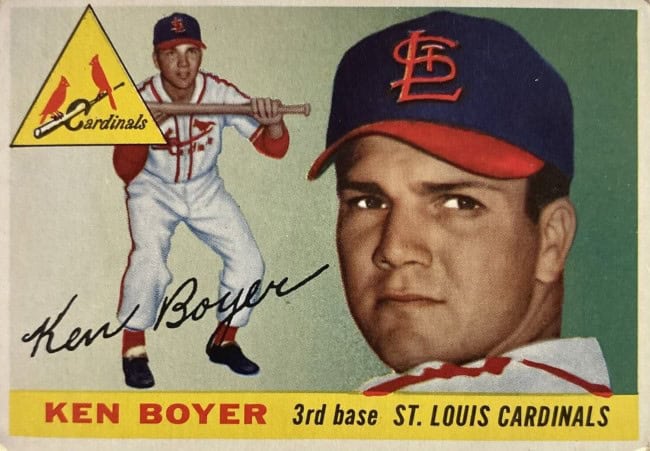
Ken Boyer, spent eleven seasons (1955-1965) with the St. Louis Cardinals, a stalwart at third base and a key contributor to the team’s success in the mid-1960s. Boyer’s legacy lies in his well-rounded skill set, combining exceptional defense with consistent hitting.
While Boyer lacked the spectacular statistics of his contemporaries, only leading in an offensive category once in his career (119 RBI in 1964), he was a consistent, reliable hitter throughout his Cardinals career. For St. Louis, he recorded a career batting average of .293, with 1,855 hits and 255 home runs. He was a seven-time All-Star selection; however, it was his defensive prowess that truly set him apart. Boyer earned five Gold Glove Awards (1960-1964) at third base, showcasing his remarkable range, agility, and sure hands.
Boyer’s best season was in 1964, when he won the NL MVP award. He finished in the top 10 of MVP voting an additional three times, placing him in the same conversation as more famous hitters like Frank Robinson and Willie Mays. He doesn’t have their name recognition, but Boyer’s contributions cannot be dismissed. Boyer has the 11th highest all-time WAR among third basemen, and 14th in JAWS.
Boyer had a smooth fielding style and exceptional baseball IQ. Stories abound about his defensive mastery. “Ken Boyer played the hot corner as well as it can be played,” commented Baseball Hall of Fame writer Craig Muder. That’s not bad for someone who was originally a pitcher.
Ken Boyer is not a member of the National Baseball Hall of Fame. In fact, he has garnered a surprisingly low amount of attention for baseball’s highest honor. Nonetheless, his consistent hitting and glovework at third based make him a talented member of the Cardinals alumni.
Best St. Louis Cardinals baseball card: 1955 Topps Ken Boyer #125 (RC)
Ken Boyer’s rookie card comes from the icon 1955 Topps set and features both a portrait and action photo. It’s similar in design to the 1956 Topps card, which is a good choice in its own right. The 1955 Topps card costs around $300 for a PSA 8, or $30 in ungraded condition, making it one of the most affordable vintage Cardinals baseball cards.
6. Joe Medwick
Player History
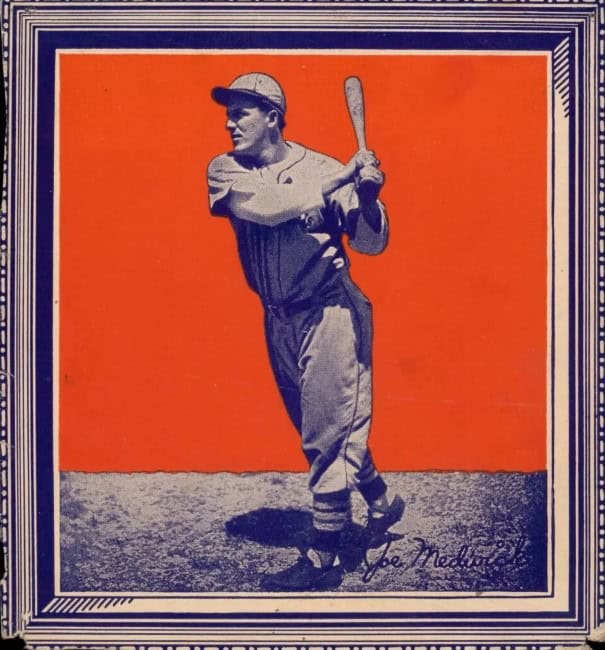
Joe Medwick, nicknamed “Ducky” or “Muscles,” patrolled the left field for the St. Louis Cardinals for ten seasons (1932-1940) during the famed “Gashouse Gang” era. He established himself as one of the most feared hitters in the National League, known for his potent combination of power and average.
Medwick’s tenure with the Cardinals was a period of offensive dominance and individual accolades. He captured the prestigious Triple Crown in 1937, leading the National League in batting average (.374), home runs (31), and RBIs (154). The batting average and RBI remain the highest for any National League Triple Crown winner since. He also won the MVP that year. He finished in the top 5 of MVP voting the two prior seasons, and finished seventh in 1939. Medwick also earned seven All-Star selections.
Medwick had a smooth, compact swing that generated line drives to all fields. “I never cared where the strike zone was. I wasn’t looking to walk. Didn’t make no difference to me, high or low, inside or outside,” said Medwick.
Joe Medwick’s offensive dominance during the Gashouse Gang era solidified him as a Cardinals legend. His Triple Crown achievement and MVP season cemented him as one of the greatest hitters of his generation.
Joe Medwick was elected to the National Baseball Hall of Fame in 1968.
Best St. Louis Cardinals baseball card: 1935 Wheaties Joe Medwick
Because he played before the commercialization of baseball cards, Joe Medwick’s rookie card is in an obscure set. This 1935 Wheaties card lets you have a card from Medwick’s prime at an achievable price. Wheaties cards from the 1930s came from cereal boxes, making it difficult to find versions in good condition. However, the cards themselves are not super-rare. They cost $50-$100, assuming they’re cut well.
5. Ozzie Smith
Player History
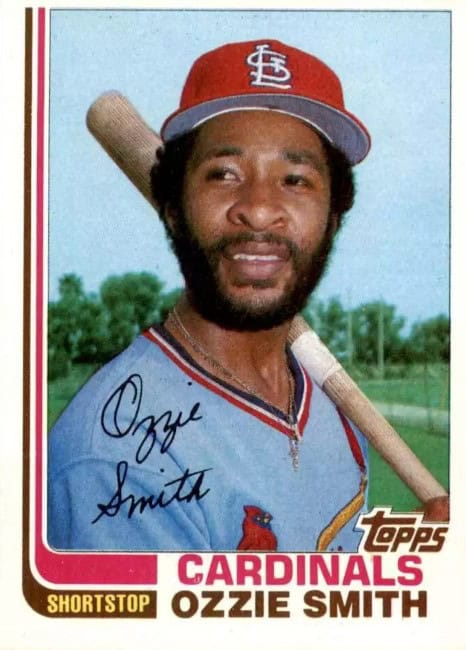
Ozzie Smith, nicknamed “The Wizard” for his seemingly impossible defensive plays, patrolled the shortstop position for the St. Louis Cardinals for fifteen seasons (1982-1996). While not known for his offensive prowess, Smith’s defensive brilliance transformed him into a Cardinals legend.
Smith’s Cardinals career was a masterclass in defensive artistry. He won an astounding thirteen consecutive Gold Glove Awards (1980-1992), a National League record for shortstops. He consistently led the National League in fielding percentage multiple times (eight) and established himself as one of the greatest defensive shortstops ever. While his offensive statistics were respectable, his true impact came on the defensive side of the ball. Notably, his game-winning home run in Game 5 of the 1985 National League Championship Series against the Los Angeles Dodgers is a cherished memory for Cardinals fans. However, it was his defensive wizardry that truly defined his career.
Smith had exceptional range, agility, and a smooth, effortless style at shortstop. He possessed a knack for anticipating plays and making the seemingly impossible look routine. His infectious enthusiasm and highlight-reel plays made him a fan favorite throughout his Cardinals tenure. However, injuries hampered him later in his career, leading to his retirement in 1996.
Known for his defense, Smith had respectable offensive numbers too. He had 1,944 hits for the Cardinals (2,460 in his career) and a .262 batting average. He also stole 57 bases at the peak of his career. In 1987, the best season of his career, he finished second in MVP voting after hitting .303 and recording 6.4 WAR (including 2.4 dWAR).
Ozzie Smith was elected to the National Baseball Hall of Fame in 2002.
Best St. Louis Cardinals baseball card: 1982 Topps Traded Ozzie Smith #109T
Ozzie Smith started his career in San Diego, so his rookie cards depict him in Padres gear. Therefore, the card we suggest his 1982 Topps Traded card. This is his first Cardinals baseball card (he was traded to St. Louis mid-season). It’s also the year the team won the World Series. The card comes from a famous set that also featured Cal Ripken Jr.’s rookie card. Smith’s card is about $50 for a high grade PSA 8 or PSA 9. (Expect to pay about ten times that for a PSA 10.) Ungraded cards are available for about $15-$20.
4. Bob Gibson
Player History
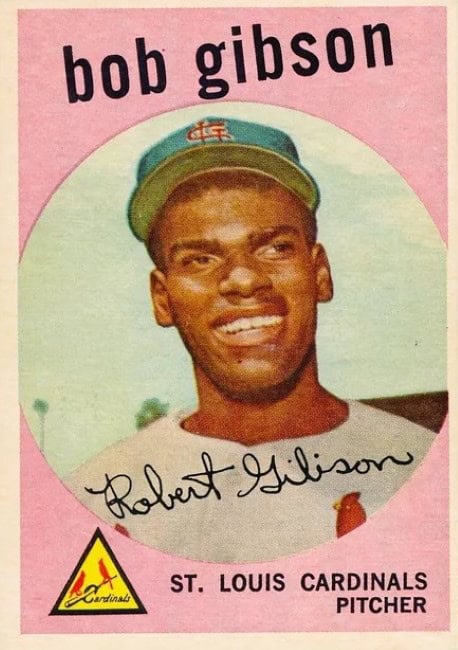
Bob Gibson, nicknamed “Gibby,” spent his entire 17-year Major League Baseball career (1959-1975) with the St. Louis Cardinals. He primarily pitched as a starting pitcher, establishing himself as one of the most feared hurlers in baseball history.
Gibson’s tenure with the Cardinals was a period of pitching excellence and postseason dominance. He won two Cy Young Awards and made nine All-Star Games. While never leading the league in strikeouts, his strikeout totals were consistently impressive.
Bob Gibson’s 1968 season stands as one of the most dominant pitching performances in baseball history. He led the National League with a microscopic 1.12 ERA, the lowest mark in the “live-ball era” that began in 1920. This remarkable feat came across 34 starts. He struck out 268 batters and completed a staggering 28 games, including 13 shutouts. His dominance propelled the Cardinals to the National League pennant. While they fell short in the World Series, Gibson’s 1968 season remains etched in baseball lore.
Gibson was also remarkably dominant in the playoffs. Across three World Series appearances and nine games started, Gibson compiled a remarkable 7-2 record. He also had a microscopic 1.89 ERA and struck out 92 batters. He was twice awarded the World Series Most Valuable Player Award, solidifying his status as a postseason legend. Gibson’s finest playoff game was a dominant shutout performance in Game 1 of the 1968 World Series. He struck out 17 Detroit Tigers hitters, a World Series record that still stands.
Gibson was a pitcher known for his overpowering fastball, exceptional control, and fierce competitiveness. He possessed a laser-like focus on the mound and an intimidating presence that unnerved opposing hitters. He was known for throwing inside, and not being friendly with opponents off the field or at All-Star games. “If you ever saw Gibson work,” said veteran catcher and broadcaster Tim McCarver, “You’d never forget his style: his cap pulled down low over his eyes, the ball gripped – almost mashed – behind his right hip, the eyes smoldering at each batter almost accusingly.”
Bob Gibson was elected to the National Baseball Hall of Fame in 1982 on the first ballot.
Best St. Louis Cardinals baseball card: 1959 Topps Bob Gibson #514 (RC)
Bob Gibson’s 1959 Topps rookie card is the headliner of a set that also includes notable cards from Mickey Mantle, Willie Mays and Hank Aaron. There are only three PSA 10 Gibson cards known to exist, and less than 50 PSA 9. Those cards can cost six figures. Near-mint PSA-graded Bob Gibson Cardinals baseball cards cost a more attainable $2,000-$6,000.
3. Rogers Hornsby
Player History
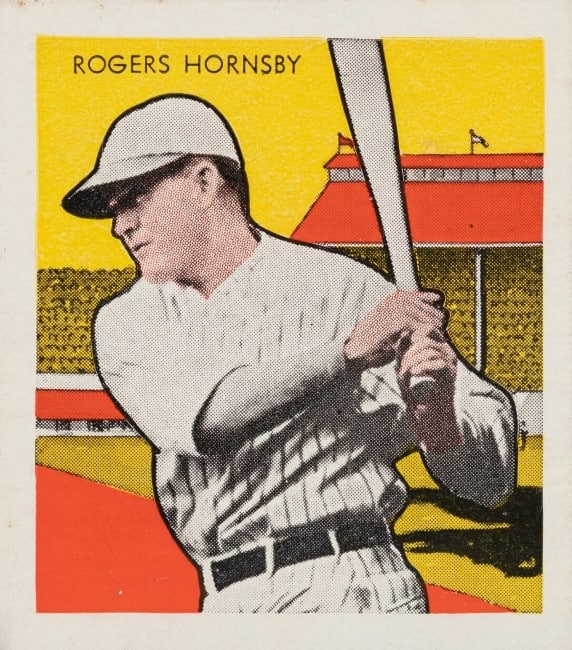
Rogers Hornsby, nicknamed “The Rajah,” patrolled the infield for the St. Louis Cardinals for twelve seasons (1915-1926, 1933). Many consider him to be the greatest right-handed hitter in major league history.
Hornsby’s time with the Cardinals was a period of offensive dominance. He led the National League in batting average a staggering seven times, including a remarkable six-year stretch from 1920 to 1925 where he averaged an unheard-of .402. Twice during his Cardinals career, Hornsby achieved the prestigious Triple Crown, leading the league in batting average, home runs, and RBIs in a single season (1922, 1925). He also holds the distinction of being the only player in major league history to hit 40 home runs and bat over .400 in the same season (1922). Notably, his 1924 batting average of .424 remains the highest single-season mark in the modern era (post-1900). While his trophy case lacks an MVP award (introduced in 1931), Hornsby’s offensive feats speak for themselves.
Hornsby was a player with a unique approach to the game. He choked up high on the bat and stood very close to the plate, maximizing his bat control. He had intense focus and relentless pursuit of hitting perfection. Stories abound about his dedication, such as his reported refusal to read anything but headlines to preserve his eyesight for hitting. However, his fiery personality often clashed with managers and teammates. Despite his occasional outbursts, Hornsby’s teammates acknowledged his unmatched hitting talent and his contributions to the team’s success. He returned to the Cardinals later in his career as a player-manager in 1933, but his managerial tenure was short-lived.
Rogers Hornsby was elected to the National Baseball Hall of Fame in 1942.
Best St. Louis Cardinals baseball card: 1933 Tattoo Orbit (R305) Rogers Hornsby
Rogers Hornsby’s last season with the Cardinals saw him placed in the 1933 Tattoo Orbit set, which was produced by the Orbit Gum Company. It shows Hornsby in a vibrantly-colored card. Hornsby’s card was a short-print, so it can be hard to find, and it has never been graded above PSA 7. In mid-grade condition, the card costs around $200-$600.
2. Albert Pujols
Player History
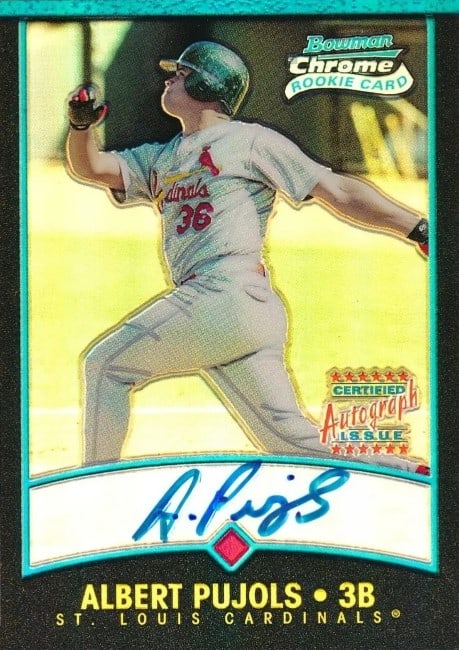
Albert Pujols, nicknamed “The Machine” for his consistent hitting, spent the first 11 seasons (2001-2011) of his illustrious career with the St. Louis Cardinals, plus his final season in 2022. During this time, he established himself as one of the most feared hitters in baseball history, combining raw power with exceptional plate discipline.
Pujols’ tenure with the Cardinals was a period of offensive dominance and individual accolades. He won the National League Rookie of the Year award in 2001 and went on to claim three National League Most Valuable Player (MVP) awards (2005, 2008, 2009). He was a nine-time All-Star selection and earned two Gold Glove Awards at first base (2006, 2010). Statistically, Pujols was a force. He led the National League in batting average once (.359 in 2003) and RBIs twice (137 in 2003, 133 in 2006). Notably, he joined Rogers Hornsby as the only Cardinals players to record both a 40-home run season and a 200-hit season (2006).
Beyond the statistics, Pujols was a player with a unique combination of power and patience. He possessed a smooth, effortless swing that could generate immense power, while also displaying remarkable discipline at the plate, drawing walks at a high rate. Stories abound about his dedication to the game, such as his legendary work ethic in the batting cages. His quiet demeanor and focus on fundamentals earned him respect from teammates and opponents alike. He played a crucial role in the Cardinals’ World Series victories in 2006 and 2011, earning the World Series Most Valuable Player Award in 2011.
When Pujols left St. Louis, he was second all-time in most offensive categories, including slugging percentage, home runs and RBI. His numerous accolades, combined with his consistent excellence, solidified his place as a Cardinals legend. Albert Pujols is not yet eligible for the National Baseball Hall of Fame, but with his overall career accomplishments, his enshrinement is a near certainty.
Best St. Louis Cardinals baseball card: 2001 Bowman Chrome Refractor Autograph Albert Pujols (RC)
Like Yadier Molina, collectors have their pick of Albert Pujols cards, including over a dozen rookie Cardinals baseball cards and associated parallels. The 2001 Topps Traded and 2001 Topps Chrome are popular choices, but the really special one is the 2001 Bowman Chrome Albert Pujols autographed card. Only 500 hand-numbered cards were made available by redemption cards in packs, so all of those that can exist are already out in the market. The card has sold as high as $168,000 for a PSA 10, but most high-grade cards are in the $10,000-$20,000 range. It’s worth noting that ink on some of the cards has faded with time, so make sure you look at the autograph carefully before buying.
1. Stan Musial
Player History
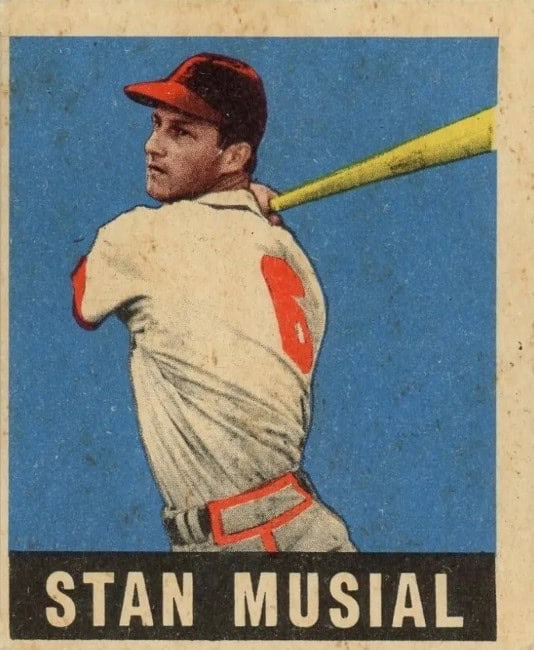
Stan Musial, affectionately nicknamed “Stan the Man” by Cardinals fans, spent his entire 22-year Major League Baseball career (1941-1963) with the St. Louis Cardinals. He primarily played outfield, but also saw time at first base, establishing himself as one of the most consistent and well-rounded hitters in baseball history.
Musial’s Cardinals career was a glittering display of offensive excellence and longevity. He won three National League Most Valuable Player (MVP) awards (1943, 1946, 1958) and was selected to a remarkable 24 All-Star Games, a record surpassed only by Hank Aaron. Musial never led the league in a single offensive category, but his consistency was unmatched. Over his career, he hit .330 or higher an astounding twelve times. He retired with 3,630 hits, the National League record at the time (since surpassed by Pete Rose).
ESPN described Musial as one of the five greatest baseball players of all time, with stats comparable to more well-known sluggers like Joe DiMaggio and Hank Aaron. Musial had the fourth-most hits in MLB history, while also hitting a career .331 batting average and nearly 500 homeruns. “He was the best hitter I ever faced,” said Braves pitcher Warren Spahn. “But he was more than that. He was a complete player.”
Stan Musial was elected to the National Baseball Hall of Fame in 1969 on the first ballot.
Best St. Louis Cardinals baseball card: 1948 Leaf Stan Musial #4 (RC)
The 1948 Leaf set is iconic on its own – as the first post-War color card set, and includes so many famous cards. Musial’s rookie is one of the headliners. The card shows Musial swinging his bat against a solid blue background, with his name in black and white at the bottom of the card. PSA has never recorded a PSA 10, but high grades generally sell for around $20,000-$25,000. For a value buy, mid-grades cost between $1,000-$2,000 and still look excellent all of these years later.
Tags:
Share:
